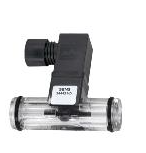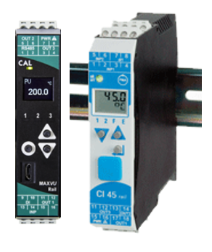A transmitter is an electronic device used to read an input value from a measuring device and convert that signal to a corresponding scaled linear output signal. What appears on the display will represent the units of measurement sensed by the measuring device.

The controlled variable is measured by a suitable sensor and converted to a signal acceptable to the transmitter. The transmitter receives that signal and converts it to a value representing the appropriate unit of measure. The transmitter also converts that input signal to an equivalent output signal to be used or monitored elsewhere in the application. Alarms and communication can also be programmed into the transmitter.
Example:

Gems FT-110 Series continuous turbine flow sensor measures potable water flow in a drinking water dispensing system and sends a pulsed VDC output via sinking open collector to a PMA CI45 Rail Line Series Transmitter. The transmitter converts that frequency input signal in hertz (Hz) to read anywhere from 0.2 to 2.0 gallons per minute (G) on the display. The transmitter also converts the frequency input to an equivalent 4-20 mA linear output signal to a recording device which calculates the total gallons used. The CI45 transmitter is also programmed to include a flow/no-flow indication relay, and serial communication via Modbus TCP over ethernet to a computer for remote monitoring.
Any West/PMA/CAL/Partlow process controller with universal input can act as a basic transmitter. The PMA CI45 transmitter described above includes added functionality with frequency input and output options. CAL offers a simplified rail mounted transmitter called MaxVU Rail. PMA also offers a strain gauge transmitter the SG45.
Gems Sensors & Controls and West Control Solutions are happy to offer transmitters to help with your process value retransmission needs. See more HERE.
 SEARCH OUR RESOURCE CENTER
SEARCH OUR RESOURCE CENTER

